In earlier posts I have tackled, I think, all of the aspects about to appear within this one, but I think it’s worth having them here in one collection, under a heading which makes it easier to find. On top of that, the argument is a common one, and probably cannot be answered often enough. Sooner or later, every atheist is challenged to address all of the benefits of religion that we must do without if we had a completely secular society, so let’s take a close look at these benefits.
The first thing we need to consider is that ‘benefit’ can be construed a lot of different ways, which I’m going to break down into just three for the sake of simplicity, and to ensure that the distinction is clear. There’s personal benefit, which doesn’t extend past the individual; there’s social benefit, which provides a general improvement to a group, town, or culture; and then there’s overriding benefit, which is as close to universal as anything might be, crossing cultural and racial and national boundaries. Few topics can actually fit into this latter one – even vaccines depend on both an economic structure that makes them viable for a populace, and the ability to both distribute them and ensure enough participation to achieve group immunity. These distinctions are important, since very frequently, the benefits of religion are treated as if they are an overriding benefit when they can barely be considered a personal one.
Another distinction that needs to be examined is if the benefit is actually demonstrable, rather than nothing but hearsay and supposition. For instance, probably the most prevalent claim in regards to the topic is how, without religion, we would be anti-social, nihilistic, and outright evil – a ridiculous number of people even seem to believe that atheism equates with satanism. Yet the actual evidence for this descent into savagery is completely lacking, while numerous contra-indicators lend more than a little weight to exactly the opposite effect; secular societies tend to be more social and cohesive, and certainly not completely chaotic. So any claims for benefits should be more than just assertions, but backed with solid evidence – this shouldn’t be hard to find, should it?
Let’s take a look at more of the most common claims of benefit:
Religion is a force for peace – For this to even be plausible, we should expect two things: that deeply religious societies have a lower percentage of conflict, crime, and social corruption than others; and religious motivations and/or connections to warfare be significantly lower than other motivations. Any knowledge of either history or current world events render both of these ludicrous. From Europe’s long bloody history with the catholic/protestant schism to the current clash of shia and sunni muslims throughout the Middle East and beyond, the US’s religious justifications of slavery and racism to the righteousness of the Conquistadors, religion is instead deeply intertwined with violence and oppression. This is no surprise at all from a sociological standpoint; privilege and righteousness frequently lead to abuse. In fact, an indefensible claim of superiority, one that cannot be demonstrated in any way, quite possibly leads to more conflict: the bully whose superiority is questioned resorts to physical violence. If you think this is an inappropriate argument and not practiced by adults, go look at the news regarding the Middle East for a week.
It has been claimed that the presence of religion has actually served to temper the potential violence – without its influence, the situations would have been much worse. It’s a possibility that certainly deserves examination, but again, just raising the possibility is not in any way establishing the viability – the real work hasn’t even begun. If the claim were true, we should expect to see the manifestations of religion within conflicts to be, you know, peaceful, or restraining, or at least urging a more civilized discourse, yet this is exceptionally hard to find. Even in situations where economics or classism are surely major factors of the conflict, the appearance of religion within is easily seen as justification and motivation, rather than palliative. And of course, we cannot ignore such prominent bits of history like the Crusades and Inquisition, which are directly defined by their religious influence. Even if we could establish that they were motivated more by power or greed (and no one has effectively made this case at all,) it is clear that the purpose of religion within was not to slow things down – quite the opposite, in fact.
Religion builds communities and social cohesion – I suspect, whenever anyone makes this claim, they are imagining Amish barn-building parties and not a different church at every third crossroads and, um, all that shit above. But yes, indeed, churches do maintain a certain level of community, certainly more than the average suburban neighborhood in the US, and they do lend themselves to generating cohesive goals, or at least ideas. And this is good – as long as the goals or ideas are beneficial. It is usually assumed that they are, but the evidence proves this inaccurate far too much of the time. Legislation against same-sex marriage, or regarding ‘teaching the controversy’ in schools, or even the nonsense idea of ‘abstinence-only education,’ all comes from these same communities, to say nothing of cults, extremism, and similar manifestations – “community” does not automatically imply, “progressive.”
And far too often, the community is rather small anyway – yielding a few dozen to a few hundred people, separated from numerous other ‘communities’ of baptists, catholics, muslims, buddhists, and so on, all just down the street. It all depends on what you’re using as a comparison, doesn’t it? While any church might be better than a village full of individualistic families with no common goals, it’s much worse that a community that encompasses the entire village itself, drawing no dividing lines between personal ideologies. There are not the vast number of splinter sects among every major religion because of how much it fosters community.
Moreover, can churches even be said to build, foster, or encourage community, or are they simply taking advantage of the human trait towards this in the first place? There are millions of communities, from Facebook groups to book clubs, Mensa to the NRA – it’s not like mankind would be made up of hermits without the influence of religion.
Religions promote charity – Let’s get one thing out of the way first: I do not, in any way, consider money or efforts spent towards self-perpetuation and promotion of the church itself to qualify as ‘charity,’ any more than I consider it as such when practiced by any major corporation; again, believing that “church equals good” or “church equals charitable” is an unwarranted assumption. Can we agree on that? I hope so, but if not, think of it in the context of a church other than your own. Now, removing all of that from the equation, how much do religions really provide towards charity?
Chances are, you don’t know – very few people, outside of those doing church bookkeeping, have any idea, really. But if I ever run across a community where the church buildings are more run-down than every other house, I’ll let you know – don’t wait up nights for it. While the days where the churches and temples were the most elaborate structures in the city are largely past, it can’t be denied that they are usually expensive and well-maintained structures, to say nothing about the megachurches, teleministries, and even colleges, all built on the donations of the followers. So you tell me: are their contributions to worthy, charitable causes exceeding the amounts spent on church buildings (and priest housing, and travel expenses) by a factor of ten? Even five? I’m curious, myself, because the contributions are continually sought under the assurance that they are used for good causes…
While all this is going on, countless charitable organizations are plugging away, using minimal funds to maintain core functions while channeling most of their contributions towards the areas that need it more. Have you ever seen a stylish and elaborate Red Cross building? Wouldn’t it make you suspicious if you did?
Then we have to consider that, in an awful lot of cases, the ‘charitable’ efforts of religions are thin disguises for recruitment, and even early indoctrination. Let’s think about something for a moment: religion, by and large, is a nuanced thing, dealing with ethics and social structure and, basically, mature decisions. While we have a minimum voting age, there is apparently no minimum age for religious instruction, even though (as can be attested by virtually anyone who’s been through it) young children are not going to grasp even a tiny portion of what it is supposed to provide. The point isn’t to build core ethical values, and you’ll never see churches teaching comparative religions (at least not honestly) – the point is to hammer the ideas home very early, in the formative years, to try and establish the ridiculous stories and bizarre ideas as ‘normal.’ And that dig about ‘honesty’ above isn’t a cheap jab – the misinformation spread by churches and religious groups is rampant, concerted, planned, and intentional. Are you sure that ‘day care center’ is solely concerned with helping the young mother with her children? If a parent requested that no religious viewpoints be expressed to their child during this care, do you believe that will be respected, or even that the ‘charity’ will not be withdrawn at that point?
The same can be said for the various programs and clinics aimed at adults, as well – it’s an extremely common tactic to target the disadvantaged and down-on-their-luck, leveraging their vulnerability to try and convince them of the love of the church. That’s fine, really, but when there are strings attached, we’re not really hitting the definition of charity, are we? Alcoholism programs that require religious services, financial counseling that continually promotes a faith in god? Are these necessary, or even germane? And how many of these come from the same parishioners who fret and babble about the ‘secular agenda’ of teaching evolution and permitting abortions? But I suppose manipulation is okay, as along as it’s the right kind of manipulation…
[A quick aside: In the neighborhood we just left, I routinely received visits from a near-homeless guy, living on welfare and scrimping for money to get by. At christmas, he was given a rather elaborate bible by some religious soul, obviously warmed by their own largesse. Not, apparently, by their sense, since he was illiterate and couldn’t read at all – I’m sure he would have benefited more from just a decent meal. His few bills, by the way, were paid by the state, not any of the umpteen churches in the area…]
Crediting the churches with their charity efforts, even if no self-serving aspects are to be seen, still remains a bit selective, considering how many other charitable organizations exist – it’s not like religion has a monopoly on the practice. On the rather frivolous website theChive, content is primarily reposted or solicited humor, trivia, and cheesecake photos – but when they hold a charity drive (which is often,) the results are astounding. There is no appeal to salvation, status, moral responsibility, or really, anything at all except the background of those in need, and the bare challenge to meet/break the goal – and invariably, they achieve this within hours. No one needs the input of religion to be charitable. And, it deserves to be said in recognition of the previous claimed benefit, theChive’s web ‘community’ is undoubtedly larger than 95% of the churches in the world…
Religions offer moral and emotional support – Hard as it may be to believe, I find this a noble practice; everyone, at one time or another, just needs a little social interaction and support, even when it doesn’t actually change their situation at all. Our own mental perspectives have a lot to do with how well we cope with adversity, and simply ‘being there’ for someone can mean a lot.
Yet, the perspective thing can go both ways. The overriding aspect of most religions – that there is some form of being that intended for things to be this way – has its own input into how people view their personal situations. Within most religions, there is no ‘shit happens’ – no random events, no impersonal effects of mere physics. Instead, we are asked to believe that everything happens for a reason, a grand plan that we are not privy to, and of course this includes all of the bad things that happen to people. This is no minor thing; it has such a significant impact that a major branch of religious philosophy, theodicy, is devoted to hashing out the problem of evil from a loving god. Maybe in another few thousand years they’ll get it to the point where people are no longer bothered by it…
In the meantime, we have to recognize that judgment and damnation, or the planned death of our children, has a fierce impact on our emotional states. That merely feeling horny as a youth, instead of being a perfectly natural and biologically functional thing, is often considered wicked. That even a simple mistake can be responsible for ruining one’s entire afterlife. Oh, yeah, religions often provide us with an afterlife to look forward to, which is great – provided, of course, that one does not waste the entirely of their presentlife fretting over making it to the right side after death, and there are an awful lot of these people.
Even something as simple as moral guidance can be problematic, since the religious definition of ‘moral’ often leaves a lot to be desired (see ‘force for peace,’ above.) Rather than coping with the incredibly difficult concept of being beneficial to as great a number of people as possible, religious morality usually involves selective quotes from scripture and a serious dose of self-righteousness; there has only been a few million people killed because they were ‘heretics’ and deserved it. Even if we can somehow establish that homosexuality is truly immoral, laws against gay marriage don’t actually affect it in the slightest, do they? They only exist to register the disapproval of the vapid devout. This is what comes from failing to understand what the function of morality even is.
And like charity above, moral and emotional support isn’t exactly a hard thing to provide; aside from the numerous individuals that are perfectly capable of rendering this elaborate assistance, there are plenty of professional organizations that do the same – without baggage, without strange rules, without skewed perspectives. In my own personal experience, I’ve spent no small amount of time helping friends cope with the emotional and perspective problems stemming entirely from religious sources. Without those influences, they would have been in a much better state of mind.
Religion is, and has been, an inspiration for the greatest works of art throughout history – Paintings, music, sculpture, literature – our museums are filled with references to religious themes and inspirations, true enough. And this applies as long as you don’t include any art at all from the last two centuries, where religious themes have become so minimized that it effectively disproves the idea. There are, however, a few contributing factors behind this apparent inspiration. The first is, we have almost nothing from the Middle Ages on back – most works have vanished, and even the historical record is sporadic and fragmented badly. The Renaissance, of course, is what most people are thinking of when they speak of this topic, and that’s when the churches were commissioning these works directly – with what money, anyone can surely wonder. The churches were also responsible for preserving them (when they didn’t alter them to reflect the more uptight tastes of later church authorities.) Anyone who believes Leonardo Da Vinci or Michelangelo were divinely inspired is perhaps unfamiliar with the commentary Leonardo repeatedly slipped into his works, and the anatomical studies that may well have prompted the shape of a brain in Michelangelo’s Creation of Adam. It is also worth noting that, of most of the religious works to be found, creative interpretations abound, much more so than scriptural accuracy.
Literature has its own special qualities. Overall, religion is a story, relating remarkable, epic events and larger-than-life people, the staple of all storytelling (who wants to hear about what I did yesterday?) As such, religious motifs lend themselves to creative interpretations and expansions, which carries over into music as well. But if we ignore the selectivity, we find plenty of other subjects tackled at every point throughout history, love being far and away the biggest, closely followed by tragedy.
And finally, like charity and community above, can we even remotely propose the idea that, without religion, far fewer works of art would have been made? It’s possibly true enough from the monetary angle, since (in part due to the churches themselves) many people lacked the funds to commission their own topics, but do we honestly believe Michelangelo would have taken up gardening instead? Without Shakespeare, we wouldn’t have as many derivatives of Romeo and Juliet and Macbeth around, but would we actually have fewer movies and plays? There is a notable difference between using religion as a theme, and crediting religion for the artistic ability.
Religion makes people feel good – Despite the vague nature of this claim, I really have heard it expressed as a benefit, more than once. Taken all by itself, it might be somewhat useful, and in fact, it likely serves as one the biggest supporting factors claimed for religion in the first place. More on this in a second.
First off, it’s not like our society, or most for that matter, has any shortage of indulgences – put in a DVD, eat some ice cream, fire paint pellets at total strangers. Seriously, the way this is often expressed, we’re expected to believe people’s lives would be total shit without religion. In a few, isolated cases, this is probably true, but not for most, and certainly not in a way that justifies the huge emphasis it is given within our cultures.
Secondly, feeling good is that personal benefit pointed out in the beginning – nothing wrong with that, but again, hardly worth the effort. ‘Feeling good’ is also a perfect justification for drug addiction, isn’t it? Hey, I feel good calling religious people self-indulgent twits…
It is the same kind of perspective that causes the religious to defend their personal choice, which is just ducky; keep it personal, and you won’t hear a word from me. Yet, there isn’t much about religion that’s personal in any way, and even those who manage to keep their mouths shut are still influenced in how they vote, what they teach their kids, and what views they have on ethics and society. Liking Metallica is a personal choice; we’re never going to see any proposed legislation regarding it, are we?
Feeling good should probably also come with at least a modicum of value and supporting evidence, as well. Countless cultures throughout history undoubtedly felt good about their exalted status as god’s chosen, or the master race, or the enlightened – was that worth encouraging and protecting? Perhaps we need a bit higher goals than that.
Many aspects of religion are tailored specifically to make people feel good – that’s the selling point, and the reason why it still exists. You will be rewarded, god loves you, there is a goal, you will not die, and on and on. Now, this can be done for anything, if our only criteria is to feel good – it’s called a motivational poster. The rot sets in when it’s incorrect, misleading, or fosters detrimental actions or attitudes – again, some standards would be useful here.
Most especially, the personal benefit angle crashes spectacularly when it’s tied to something detrimental to someone else, something that all of those who assert their ‘personal choice’ tend to forget, conveniently. So much for moral guidance. And this applies to every benefit mentioned above, and all others as well; defending religion by selecting only those items that sound good while ignoring those that are extremely, irrefutably damaging is reprehensible, and hardly worthy of the minds we have. I’ve said it before and will need to keep saying it: there is no reason to try and determine the balance, how the scales end up weighing. Do good; don’t so bad. That’s all the elaborate, nuanced, complicated guidance that’s necessary. If your idea of ‘good’ targets others or reinforces your own status, you need to exercise more thought in the matter.
This tendency towards selectivity needs further critical examination. The Crusades and Inquisitions mentioned above did not just happen despite the influence of religion, they never would have occurred without it. The ideas of witches and demons and holy lands do not come from anyplace else. Even when the participants actually believed they were doing good, this definition of good was created solely by religious influence (to say nothing of those who were only using religion as an excuse to consolidate their power or status – I’ll leave you to speculate on how many that might have been, and how poorly religion worked to temper their actions.) When it comes right down to it, just about every time that someone wants to speak of the benefits of religion, it is to try and offset the pretty goddamned nasty aspects that are also part and parcel, things that we wouldn’t have had without religion in the first place. It’s a desperate attempt to justify their personal viewpoint, conveniently ignoring the long, bloody history in favor of… what, exactly?
I’m also not impressed with the arguments, which always appear, that all of that above is not my religion, the sudden, distinct dividing line that gets created whenever anyone is observant enough to note all the bad stuff going on. Up until that point, of course, religion is usually used in a universal sense, with great emphasis put upon the sheer numbers encompassed within that overriding, ill-defined descriptor. There are two things that I’ll observe, in response. The first is that I have never, ever seen any self-professed religious person challenge the statement that religion is good; the challenges only appear when the umbrella term that they shelter under is no longer a point in their favor. Second, the exact same traits that they follow, emphasize, and venerate by even being part of a religion are what’s responsible for that list of pseudo-benefits above. Since we’re now in the realm of fine distinctions, what’s the fine distinction that makes their faith good? Isn’t that the important bit? Even if we want to consider religion a force for both good and bad, what’s the point that’s being made then?
I’ll be the first to point out that human nature produces a lot of the behavior we’ve seen throughout history and still see today; I will never say that eradicating religion will eliminate conflict and abuse, and make everybody love one another. But to try and take religion, as a whole, and assign it any properties at all, much less beneficial ones, to permit some handy little label is ludicrous beyond reason. If someone wants to be considered good, then they should do good things, not seek out an association with a cultural convention. If they’re inspired by religion to do it, fine, no problem – others may be inspired by simple empathy, fairness, and the sense of ethics that we’ve evolved to have over millions of years. However, to make any claim at all that religion deserves credit for benefits, and is thus worthy of a ‘good’ status, is an exceptionally shallow, superficial, and above all self-serving perspective. We can do better.




















































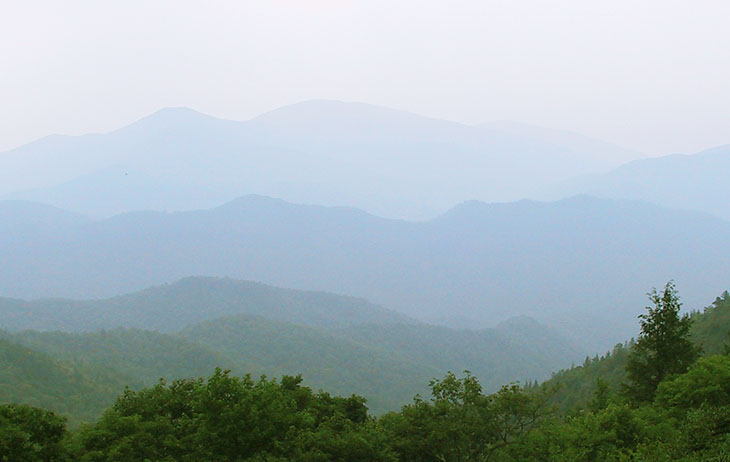
 Anyway, a brief break for the fartsy stuff, since I don’t
Anyway, a brief break for the fartsy stuff, since I don’t 
 I just liked the effect of the backlighting and shadows.
I just liked the effect of the backlighting and shadows.
 Sometimes it’s more how you take it than what you take. It’s easy enough to get photos of lily pads, but do they look better by taking advantage of the way the light and reflections provide contrast with a rich indigo color, and a little effort in framing? Subtle changes to position and shooting angle can change your images radically, communicating the setting while providing a little eye-catching abstraction. Or maybe not – that’s really up to you, and I’m on the edge of doing that ‘art’ thing where I overexplain what it is you’re seeing.
Sometimes it’s more how you take it than what you take. It’s easy enough to get photos of lily pads, but do they look better by taking advantage of the way the light and reflections provide contrast with a rich indigo color, and a little effort in framing? Subtle changes to position and shooting angle can change your images radically, communicating the setting while providing a little eye-catching abstraction. Or maybe not – that’s really up to you, and I’m on the edge of doing that ‘art’ thing where I overexplain what it is you’re seeing.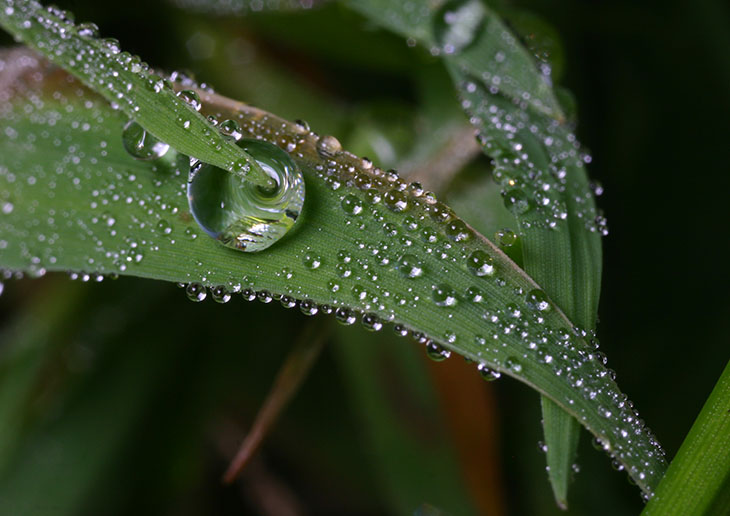
 I don’t recommend tackling high-contrast subjects in bright light conditions, which increase contrast even further – it’s too easy to go outside of the band the camera can capture effectively and start bleaching out the colors or making shadows too harsh. But sometimes it can work.
I don’t recommend tackling high-contrast subjects in bright light conditions, which increase contrast even further – it’s too easy to go outside of the band the camera can capture effectively and start bleaching out the colors or making shadows too harsh. But sometimes it can work.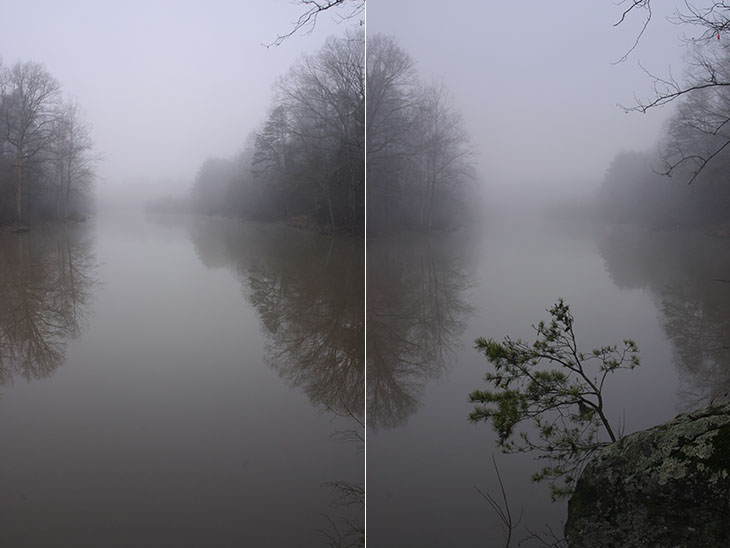
 Not an autumn shot, but a summer one, only a few weeks ago after a heavy wind and rain storm deposited a selection of leaves into a stream. If you’re paying attention to how the light differs in these images, you can see how deep shade can make colors appear differently than in sunlight, and can hopefully use this to your advantage.
Not an autumn shot, but a summer one, only a few weeks ago after a heavy wind and rain storm deposited a selection of leaves into a stream. If you’re paying attention to how the light differs in these images, you can see how deep shade can make colors appear differently than in sunlight, and can hopefully use this to your advantage.
 So, I commented not long ago about the almond tree we transplanted, which had been getting savaged by deer at the old place – they would come by every few weeks and strip half the leaves from it, returning when it had recovered. Here at the new house, it had escaped such attentions. For a while.
So, I commented not long ago about the almond tree we transplanted, which had been getting savaged by deer at the old place – they would come by every few weeks and strip half the leaves from it, returning when it had recovered. Here at the new house, it had escaped such attentions. For a while.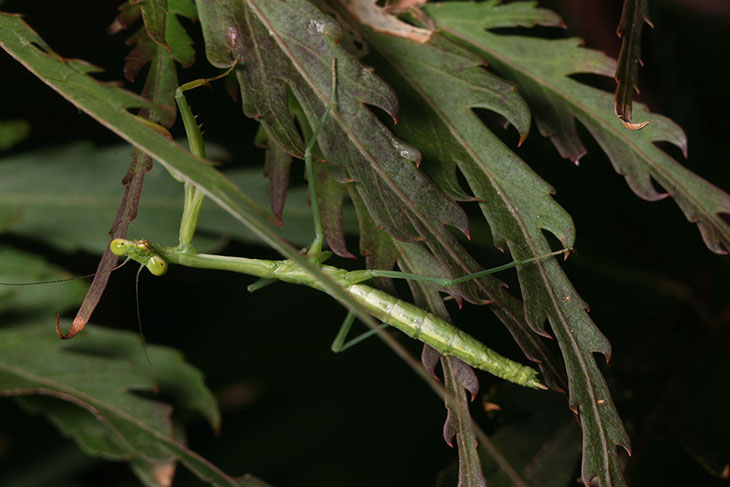
 The almond tree hasn’t fully escaped the attention of the deer. As seen here, it’s gotten cropped just a little in several places, even though the deer seems to greatly favor the lilies; you can still see new green leaves in the background. The tree’s only about a meter tall at this point and not terribly fast growing – we won’t be harvesting our own almonds anytime soon. I’m pretty laissez-faire about what animals get up to – this is how nature works, and I’m not going to improve on it – but the deer are starting to frustrate me. The almond tree was a bit of serendipity, having sprouted spontaneously in our compost pile, but messing with my photographic models is not cool.
The almond tree hasn’t fully escaped the attention of the deer. As seen here, it’s gotten cropped just a little in several places, even though the deer seems to greatly favor the lilies; you can still see new green leaves in the background. The tree’s only about a meter tall at this point and not terribly fast growing – we won’t be harvesting our own almonds anytime soon. I’m pretty laissez-faire about what animals get up to – this is how nature works, and I’m not going to improve on it – but the deer are starting to frustrate me. The almond tree was a bit of serendipity, having sprouted spontaneously in our compost pile, but messing with my photographic models is not cool. Out the other night in the yard looking for photo subjects, I found a curious bit of drama. A female reddish brown stag beetle (that’s the actual common name, scientifically named Lucanus capreolus) had gotten herself caught in a corner web and was dangling, unable to get a foothold on anything to draw herself free. Stag beetles are among the largest US beetles, certainly the most impressive in NC, this one running 35-40 mm I believe. A few days earlier I had handled one that was perched on our porch screens, attracted by the light at night – don’t pin them down and you won’t get acquainted with those lovely pincers. If you let them walk on your hand, however, those climbing hooks on their feet are hard to avoid, and she managed to get one of her feet hooked fast into my finger and couldn’t extricate herself for a minute – this isn’t exactly painful, but it’s noticeable, and you’re quite aware something is wrong. You’re also aware that grabbing it to help it get free is possibly not the best move. It is entirely possible that the one getting caught on my finger and the one seen here are the same individual; they were found only a few meters apart, a few days apart. You can’t blame it on the light attracting the beetle towards danger, however, because this is probably the darkest corner of the property, day or night, and I found this tableau by flashlight myself.
Out the other night in the yard looking for photo subjects, I found a curious bit of drama. A female reddish brown stag beetle (that’s the actual common name, scientifically named Lucanus capreolus) had gotten herself caught in a corner web and was dangling, unable to get a foothold on anything to draw herself free. Stag beetles are among the largest US beetles, certainly the most impressive in NC, this one running 35-40 mm I believe. A few days earlier I had handled one that was perched on our porch screens, attracted by the light at night – don’t pin them down and you won’t get acquainted with those lovely pincers. If you let them walk on your hand, however, those climbing hooks on their feet are hard to avoid, and she managed to get one of her feet hooked fast into my finger and couldn’t extricate herself for a minute – this isn’t exactly painful, but it’s noticeable, and you’re quite aware something is wrong. You’re also aware that grabbing it to help it get free is possibly not the best move. It is entirely possible that the one getting caught on my finger and the one seen here are the same individual; they were found only a few meters apart, a few days apart. You can’t blame it on the light attracting the beetle towards danger, however, because this is probably the darkest corner of the property, day or night, and I found this tableau by flashlight myself. The beetle wasn’t in the mood to be cooperative, so the spider seemed able or confident only in dealing with the extremities; the effectiveness of this was pretty much as you imagine. In fact, the spider probably needed to sharpen her fangs after the attempts.
The beetle wasn’t in the mood to be cooperative, so the spider seemed able or confident only in dealing with the extremities; the effectiveness of this was pretty much as you imagine. In fact, the spider probably needed to sharpen her fangs after the attempts.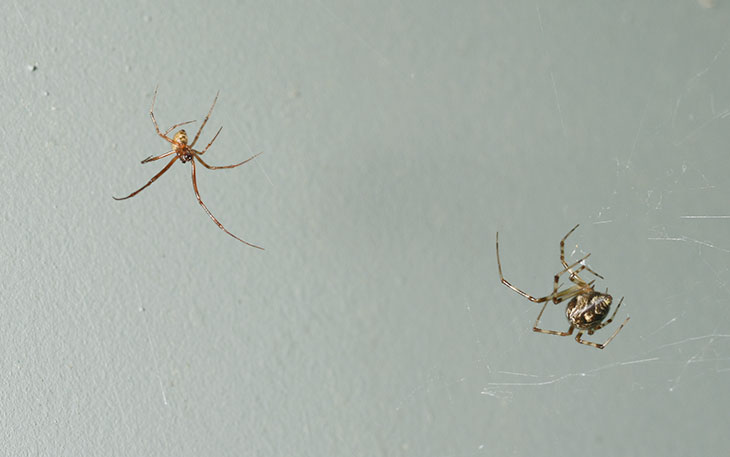
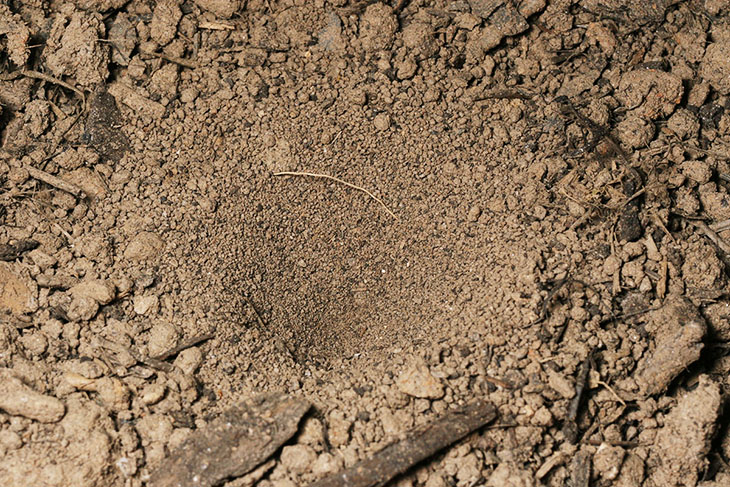


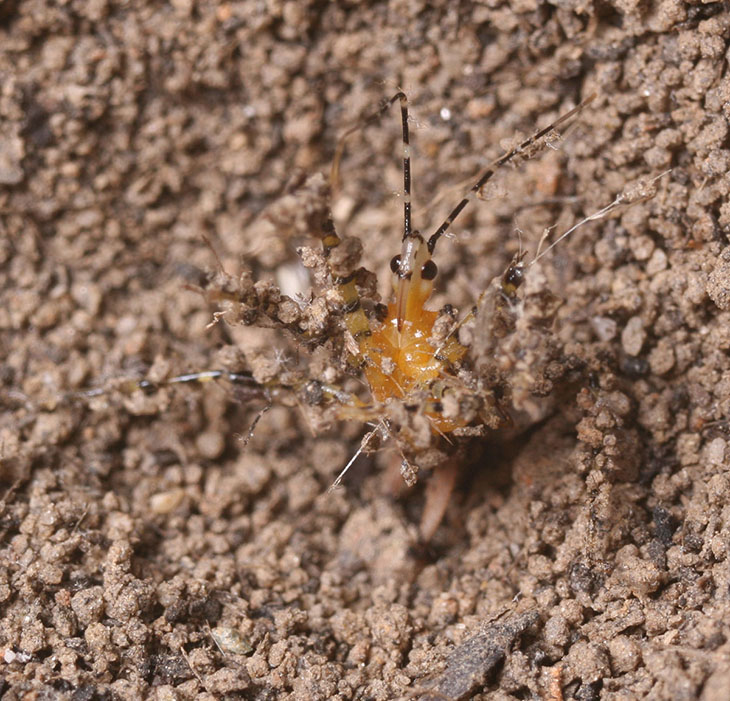


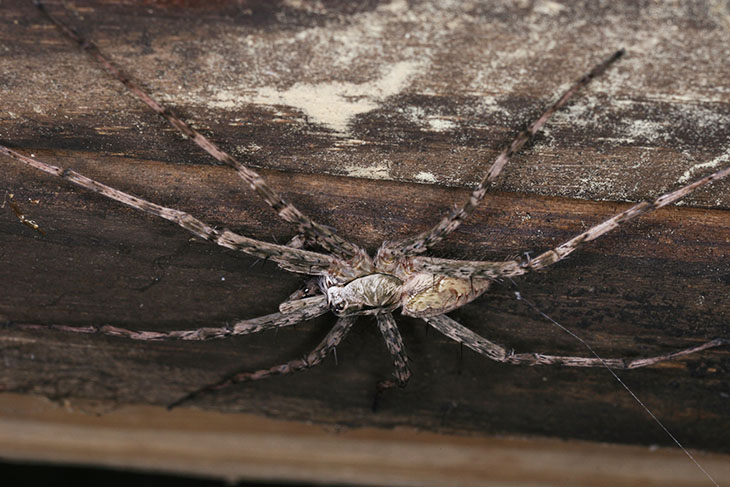

 You might remember these from the earlier post – they are, of course the fangs (chelicerae.) Curiously, every species where I’ve been able to see these, regardless of the coloration on the body, displays this same deep reddish-brown hue. I know I’m not helping anyone’s own arachnophobia by posting these so prominently, but they’re cool anyway – you can see just how small they are in the previous pic. For many a bug, this is the last thing they saw – well, okay, considering the compound eyes, it would be this, and the ground, and the sky, and the plant they were on, and the zit on their back…
You might remember these from the earlier post – they are, of course the fangs (chelicerae.) Curiously, every species where I’ve been able to see these, regardless of the coloration on the body, displays this same deep reddish-brown hue. I know I’m not helping anyone’s own arachnophobia by posting these so prominently, but they’re cool anyway – you can see just how small they are in the previous pic. For many a bug, this is the last thing they saw – well, okay, considering the compound eyes, it would be this, and the ground, and the sky, and the plant they were on, and the zit on their back… 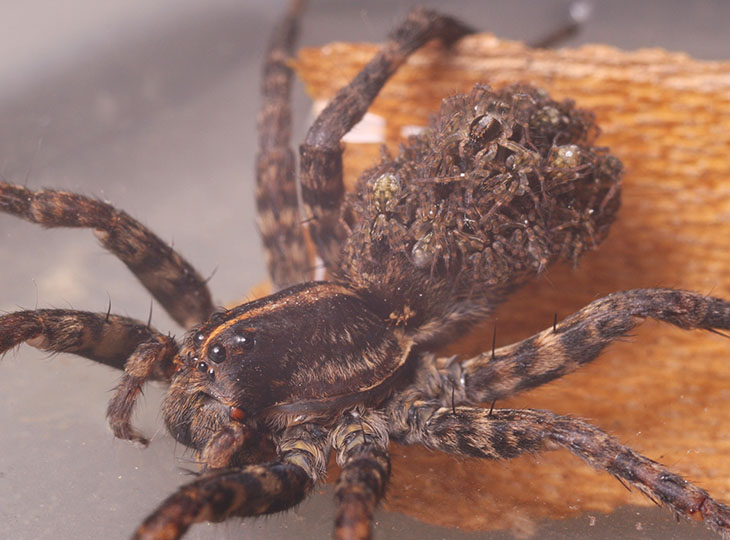
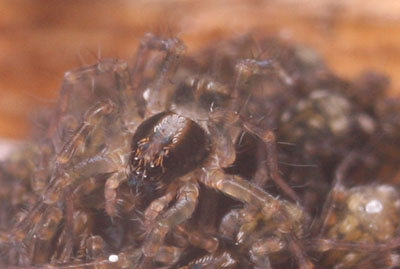 Except for this one. Brazenly exposed up on top of the stack, it takes advantage of the best view and the freshest air, perhaps serving as lookout or hall monitor, or maybe some purpose akin to the guy who drives the back end of the hook-n-ladder truck (didn’t you always want to do that? Whaddya mean, “The what?” Just how young are you?)
Except for this one. Brazenly exposed up on top of the stack, it takes advantage of the best view and the freshest air, perhaps serving as lookout or hall monitor, or maybe some purpose akin to the guy who drives the back end of the hook-n-ladder truck (didn’t you always want to do that? Whaddya mean, “The what?” Just how young are you?)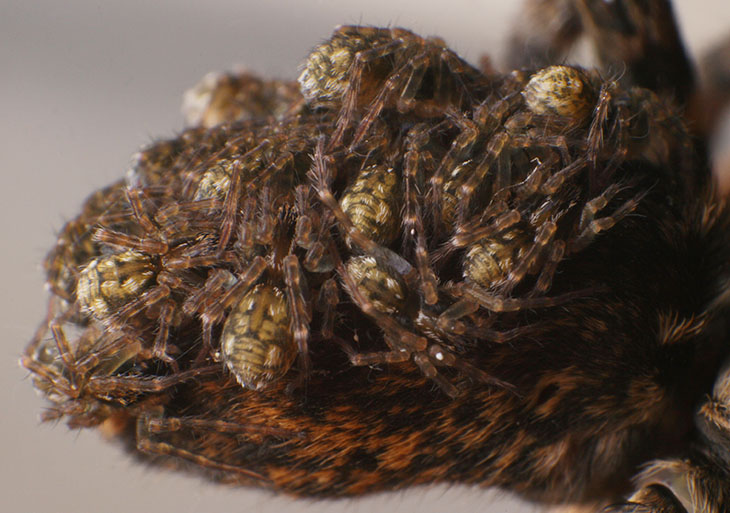

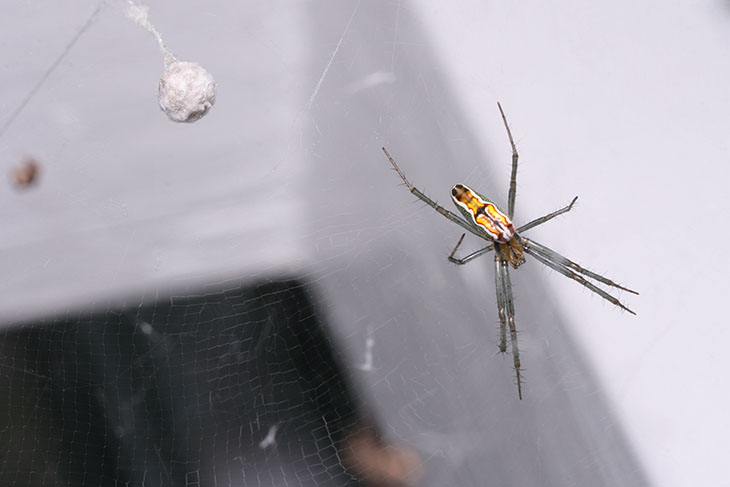

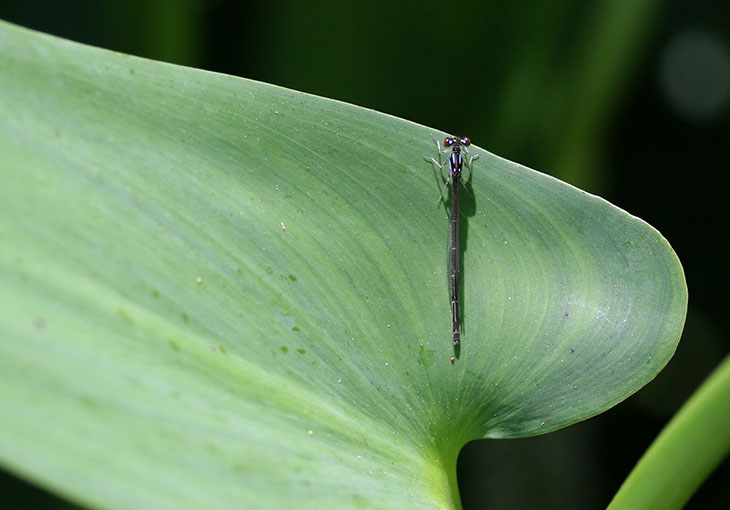
 Since the move, I’ve been taking the opportunity on occasion to scope out the new area, trying to determine what kind of decent shooting locales can be found nearby. One stroke of luck is a large pond, close and easy to get to, but so far unspoiled. It’s big enough that it will serve as foreground interest for sunrises and passing storms, and is partially bordered by a great wetlands section. I expect it’s going to contribute a lot of images to my stock.
Since the move, I’ve been taking the opportunity on occasion to scope out the new area, trying to determine what kind of decent shooting locales can be found nearby. One stroke of luck is a large pond, close and easy to get to, but so far unspoiled. It’s big enough that it will serve as foreground interest for sunrises and passing storms, and is partially bordered by a great wetlands section. I expect it’s going to contribute a lot of images to my stock.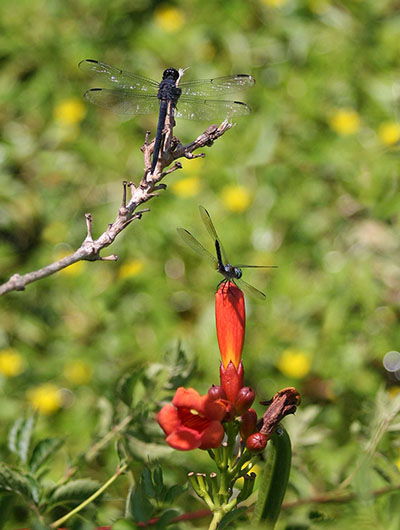 The pond area, unsurprisingly, plays home to a stunning number of dragonflies and damselflies (the difference between the two: the former has outstretched wings when sitting, like here, while the latter has wings aligned with their bodies like at the top of the post.) Both species need to have their wing muscles fairly warm to operate efficiently, which is why they perch in sunny areas so frequently, but this day was warm enough that they didn’t have to sit still very much. The one at top was cooperative and sat there for quite some time, while the pair seen here didn’t remain there together longer than 30 seconds before one or the other was off to pursue some tasty insect – they have no interest in bumblebees, by the way, and on those occasions when a dragonfly chose to perch atop one of the many flower spears, they were usually dislodged by bees within a few seconds. The nice thing about dragon/damselflies is that they often have preferred perches, and even when spooked off by an incautious movement from the photographer, may return quickly to the exact same spot. That allowed me to get these two together in the frame, though I admit this is actually a composite image. They were far enough apart in distance from the camera that one would be in focus while the other wasn’t, and stopping down to capture them together also sharpened the background to the point of being distracting and less appealing, so I combined two images where I had selected focus for either dragonfly. Shameless abuse of technology, I know.
The pond area, unsurprisingly, plays home to a stunning number of dragonflies and damselflies (the difference between the two: the former has outstretched wings when sitting, like here, while the latter has wings aligned with their bodies like at the top of the post.) Both species need to have their wing muscles fairly warm to operate efficiently, which is why they perch in sunny areas so frequently, but this day was warm enough that they didn’t have to sit still very much. The one at top was cooperative and sat there for quite some time, while the pair seen here didn’t remain there together longer than 30 seconds before one or the other was off to pursue some tasty insect – they have no interest in bumblebees, by the way, and on those occasions when a dragonfly chose to perch atop one of the many flower spears, they were usually dislodged by bees within a few seconds. The nice thing about dragon/damselflies is that they often have preferred perches, and even when spooked off by an incautious movement from the photographer, may return quickly to the exact same spot. That allowed me to get these two together in the frame, though I admit this is actually a composite image. They were far enough apart in distance from the camera that one would be in focus while the other wasn’t, and stopping down to capture them together also sharpened the background to the point of being distracting and less appealing, so I combined two images where I had selected focus for either dragonfly. Shameless abuse of technology, I know.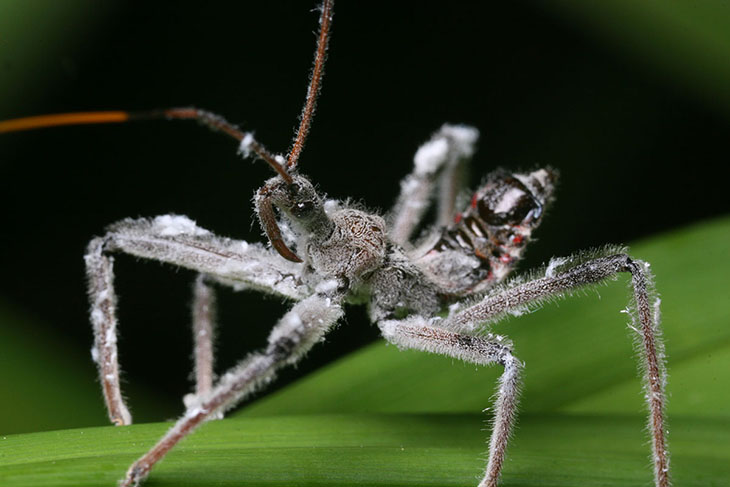

 This is quite possibly the newly-molted adult form of the same leafhopper. At the very least, those wings look like they’re still drying and unfolding, but I didn’t spot the old exoskeleton anyplace nearby, so I can’t be sure. I even went back out a little later to see if the wings were fully-extended and dry by then, but couldn’t locate the leafhopper. As above, the eyes are red because these images were taken at night. Leafhopper eyes change color like praying mantis eyes do; during the day, they display a more camouflaging hue. Presumably, this provides some advantage to their night vision, but I suppose they could also be up well past their bedtime, or suffering from allergies – must maintain an open mind.
This is quite possibly the newly-molted adult form of the same leafhopper. At the very least, those wings look like they’re still drying and unfolding, but I didn’t spot the old exoskeleton anyplace nearby, so I can’t be sure. I even went back out a little later to see if the wings were fully-extended and dry by then, but couldn’t locate the leafhopper. As above, the eyes are red because these images were taken at night. Leafhopper eyes change color like praying mantis eyes do; during the day, they display a more camouflaging hue. Presumably, this provides some advantage to their night vision, but I suppose they could also be up well past their bedtime, or suffering from allergies – must maintain an open mind.